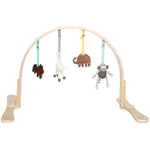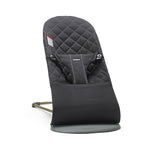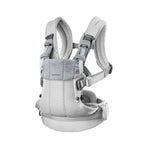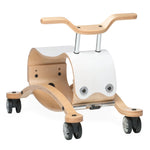Most expecting parents spend a lot of time preparing for labor and delivery and not as much time preparing for something they are going to spend many, many hours doing when baby arrives- feeding the baby!

While it is common to register for all of the feeding gadgets - nursing bras, formula warmers, bottles, etc., something that many people miss is the education piece about HOW to feed the baby and what to expect during the early days and weeks.
If you are planning on breastfeeding, the first few weeks of the third trimester is a great time to start educating yourself. If you wait to start learning about breastfeeding while you are sleep deprived and sore from your delivery with a crying baby, you will feel more overwhelmed!
Ready to start learning? Let’s dive in! Here are my best tips to help you be as successful as possible during your first week of breastfeeding:
Know Your Anatomy and Physiology
Believe it or not, you started making milk early in the second trimester. That’s why the question that people often ask after delivery, “has your milk come in?” is a silly one- you already have milk! This first milk is called colostrum and it is jam-packed with nutrients for a brand new baby. The volume of this milk is small, but that is all baby needs. This small volume is normal!
Around 2-3 days postpartum is when your milk should start transitioning to “mature milk” and the volume will increase. You will notice that your breasts feel very full and it can be uncomfortable! While a lot of this fullness is milk, it is also swelling in the area. To manage the engorgement, you should feed frequently, apply cold compresses to the breasts for 20 minutes at a time, and do some gentle massage to move the inflammation out of the breast and into the lymph system. If your breast is so full that it is difficult for baby to latch on, you can soften it with hand expression and something called reverse pressure softening (ask your nurse or lactation consultant to show you how)!
Practice Hand Expression

Hand expression is an extremely valuable tool for the early hours and days after birth! Simply, it is using your hands to remove the milk. Hand expression is very effective for removing colostrum, and moms that hand express soon after delivery have been shown to have a better milk supply later on! Hand expression is something that you can do in addition to nursing your baby and you can offer the milk to them as an “appetizer” or “dessert” on a spoon before or after nursing. (BONUS TIP: Offering milk this way can be very helpful for babies that are having trouble latching, who are extra sleepy, or are having issues with their blood sugar!)
The best time to practice hand expression is late in your pregnancy, starting around 37 weeks (discuss with your provider). This way, you can get a feel for it and what techniques work for you. (Remember- learning things BEFORE delivery is more effective than trying to learn them after!) Head to firstdroplets.com for a great video about it!
Feed Early and Often
The more you feed your baby, the more milk you will be telling your body to make. And feeding at every opportunity you can helps baby to get all of the milk they need.
A newborn should be feeding at LEAST 8-12 times in 24 hours (often they will feed more than this!) Doing skin to skin with your baby can help you to catch their earliest feeding cues. Early feeding cues include things like baby opening their eyes, opening their mouth and/or moving their tongue, and moving their head. Crying is a late sign of hunger, baby is “hangry” at that point! The nursing session will be more successful and enjoyable if you offer the breast before baby is upset.
The best way to know if your newborn is getting enough milk is by counting their diapers. On their first day of life they should make one wet diaper, on day of life two they should make two wet diapers, three wet diapers on day three, and four on day four. Easy to remember! Each of these diapers should have about 3 tablespoons of urine in it. After day four, baby should be making at least 6 wet diapers per day, and should be having at least one large poop. Most babies will lose weight after delivery, but with appropriate milk intake, they will gain this weight back by 2 weeks of age.
It can be easy to doubt your supply if baby is cluster feeding or showing signs of fussiness at the breast, and many new moms start supplementing with formula when this happens. The best thing to do if you have concerns about your babies milk intake or hydration status is to get in touch with your pediatrician and an IBCLC who can assess your milk supply and baby’s breastfeeding ability and can help you make a plan for supplementation if necessary.

Focus on Positioning
Proper positioning helps baby to get the most milk possible and helps breastfeeding to be more comfortable for you. Positioning basics:
- Tummy to tummy: baby should have their tummy against yours. If their tummy is facing the ceiling and their head is turned towards you, their latch will likely be shallow (and painful!) and it is very difficult for them to swallow like that. Try bringing baby so close that you can’t even fit a piece of paper between your tummies.
- Nose to nipple: leaving your nipple at baby’s nose level helps them “look up” to get it into their mouth. By looking up, they will open up wider. Another way to think of it is that their chin should be leading the latch when they open up wide and tip their head slightly back.
- Lean back: when you lean your body back, this helps use gravity to your advantage to facilitate a deeper latch. This is often called “laid back breastfeeding” or “biological nurturing.” When you lean back, baby is laying more on top of you, on their tummy, which helps them get most of their body in contact with yours. This helps trigger the innate feeding instincts that they are born with! Somewhere you can put your feet up so you can get into this position is ideal, like a comfy spot on your couch with an ottoman, your bed, or a recliner. (Here is the reclining glider I have in my own nursery, it’s so comfortable!)
Some discomfort can be normal in the beginning, but breastfeeding should never, ever be painful or cause bleeding. If you’re in pain or noticing nipple damage, get some help from a lactation consultant who can help you troubleshoot. (PRO TIP: If you have nipple damage, Silverette is an amazing product that can aid in healing!)
Limit Visitors
I know this tip might seem random and not really related to breastfeeding! But hear me out: If you are entertaining visitors all day, it doesn’t allow you the freedom to feed your baby on demand and you might miss a lot of those early feeding cues we discussed earlier while baby is being passed from person to person. Not to mention, you probably won’t be comfortable being half-dressed in front of most visitors!
So try not to be shy and be honest about if you are up for having visitors and how long you’d like them to stay. You can even establish “visiting hours” and let people know the specific times you’re having people over. That way you don’t have to feel bad about kicking people out if they are overstaying their welcome! Not only will limiting visitors allow you to feed baby more freely and frequently, it will allow you to not feel like you need to entertain people and you can get more rest!
I hope those tips are helpful to you as you begin your breastfeeding journey! Remember, prenatal breastfeeding education is so important in helping you to increase your knowledge and confidence about feeding baby. If you have any questions or concerns as you and your baby are learning how to breastfeed, please reach out to an IBCLC lactation consultant for support.
Come say hi on my instagram page or join my email list at goodbabylactation.com. Take care!
Looking for weekly pregnancy updates & advice from industry experts?

ABOUT THE AUTHOR
Jessica is a NICU Nurse, Lactation Consultant, and mother of three. She loves educating and supporting families so that they can feel more confident about taking care of their babies!
















